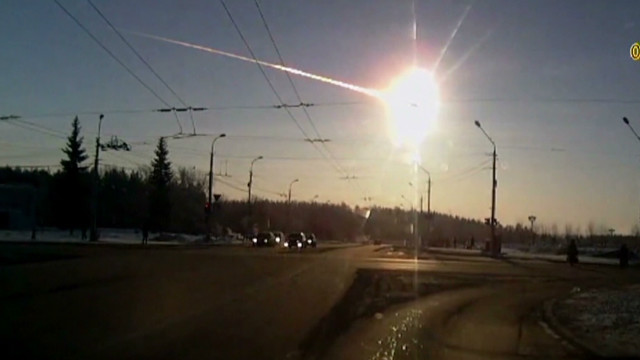STORY HIGHLIGHTS
- NEW: More than 4,000 buildings, mostly apartment blocks, were damaged, state media report
- NEW: State media: Local officials estimate the cost of damage at more than $33 million
- The meteor released a 500-kiloton blast, NASA officials say
- More than 1,000 people are hurt, most by flying glass
Although some buildings
were unscathed when the sonic waves from the Friday morning explosion
reverberated through the city and region, others lost some or most
windows.
More than 1,000 people
were injured, including more than 200 children, the news agency said.
Many of them were hit by flying glass.
Most of those hurt are in the Chelyabinsk region, though the vast majority of injuries are not thought to be serious.
Altogether, more than
4,000 buildings, mostly apartment blocks, were damaged and 200,000
square kilometers (77,220 square miles) of glass were broken, the
state-run RIA Novosti news agency cited the Chelyabinsk regional
emergencies ministry as saying Saturday.
Local officials have estimated the damage at over 1 billion rubles (over $33 million), RIA Novosti said.
The city of Chelyabinsk was functioning normally Saturday as the repair work began.
Many believe it had a lucky escape as fragments of the meteor came raining down.
West of the city,
authorities have sealed off a section of a frozen lake where it's
believed a sizable meteorite crashed through the ice.
The meteor was a once-in-a-century event, NASA officials said, describing it as a "tiny asteroid."
The space agency revised
its estimate of the meteor's size upward late Friday from 49 feet (15
meters) to 55 feet (17 meters), and its estimated mass from 7,000 to
10,000 tons.
The space agency also
increased the estimated amount of energy released in the meteor's
explosion from about 300 to nearly 500 kilotons. By comparison, the
nuclear bomb the United States dropped on Hiroshima in 1945 released an
estimated 15 kilotons of energy.
The whole event, from
the meteor's atmospheric entry to its disintegration in the air above
central Russia, took 32.5 seconds, NASA said.
About 20,000 emergency response workers were mobilized Friday, RIA Novosti reported.
Russian Emergencies
Minister Vladimir Puchkov arrived in the city of Chelyabinsk on Friday
evening to take stock of the situation, the official Itar-Tass news
agency reported.
Hospitals, kindergartens
and schools were among the buildings affected by the blast, said
Vladimir Stepanov, of the National Center for Emergency Situations at
the Russian Interior Ministry.
Amateur video footage
showed a bright white streak moving rapidly across the sky, before
exploding with an even brighter flash and a deafening bang.
The explosion occurred about 9:20 a.m. local time, as many people were out and about.
Russians captured vivid images, many using dash cameras inside their vehicles.
Dash cameras are popular
in Russia for several reasons, including possible disputes over traffic
accidents and the corrupt reputations of police in many areas. Drivers
install the cameras for their own protection and to document incidents
they could be caught in; on Friday, they were able to document a
spectacular natural phenomenon.
CNN iReporter and Instagram user Max Chuykov saw the meteor trail from the city of Yekaterinburg. He shared on Instagram that it was "close to the ground."
Witness Ekaterina Shlygina posted to CNN iReport and wrote on Instagram: "Upon Chelyabinsk a huge fireball has exploded. It wasn't an aircraft."
The national space
agency, Roscosmos, said scientists believed one meteoroid had entered
the atmosphere, where it burned and disintegrated into fragments.
Five regions of Russia,
one of them Chelyabinsk, are thought to have been affected, as well as
neighboring Kazakhstan, Itar-Tass said.
NASA said on its website
that the meteor was the largest reported since 1908, when the famous
Tunguska event took place in remote Siberia.
In that incident, an
asteroid entered the atmosphere and exploded, leveling about 80 million
trees over an area of 820 square miles -- about two-thirds the size of
Rhode Island -- but leaving no crater.
"We would expect an
event of this magnitude to occur once every 100 years on average," said
Paul Chodas, of NASA's Near-Earth Object Program Office at the Jet
Propulsion Laboratory in California. He was referring to the latest
meteor.
"When you have a
fireball of this size we would expect a large number of meteorites to
reach the surface and in this case there were probably some large ones."
In what astronomers said
was an unrelated coincidence, a larger asteroid, called 2012 DA14,
passed relatively close to Earth around 2:24 p.m. ET Friday.
Stargazers in Australia,
Asia and Eastern Europe could see the asteroid with the aid of a
telescope or binoculars, but it never got closer than 17,100 miles to
our planet's surface.
The Russian meteor was
about one-third the size of the asteroid. The two bodies were on very
different trajectories, scientists said.
Source : http://edition.cnn.com/2013/02/16/world/europe/russia-meteor-shower/?hpt=hp_t1







.jpg)
0 comments:
Post a Comment